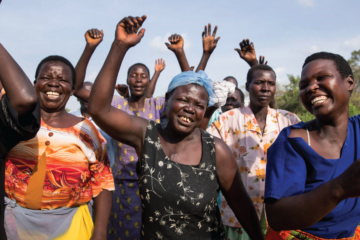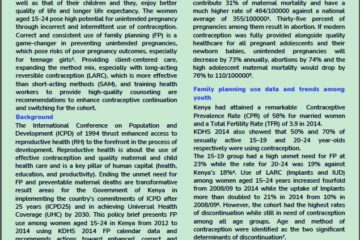
Delivery Care Is Key for Maternal Survival: A Story of Two States in Nigeria
Date
December 1, 2001
(December 2001) Yemi Omoshola, a woman from Lagos State, in southwestern Nigeria, needed blood desperately. Her doctor’s attempts to induce delivery of her overdue baby had caused excessive bleeding. Unfortunately, the hospital had no blood bank. While her husband searched for blood, Mrs. Omoshola lost consciousness and died.
This story illustrates the trauma faced by many women in Lagos and other parts of Nigeria who are about to give birth. In Nigeria, the most populous country in Africa, 45,000 women die in childbirth every year, according to the United Nations Children’s Fund (UNICEF), the United Nations Population Fund, and the World Health Organization (WHO). This represents the third highest estimated number of maternal deaths in the world. Only India and Ethiopia have more maternal deaths, with 110,000 and 46,000 respectively.
The single most effective way to reduce maternal deaths is to provide skilled care during and after childbirth, according to Family Care International, an international reproductive health nongovernmental organization (NGO). This means that the skilled attendant — such as a midwife, nurse, or doctor — should have the necessary skills and should be supported by a primary health center and a hospital with adequate supplies and equipment, as well as an efficient and effective system of communication, referral, and transport. If the skilled attendants do not have the ability to perform needed operations or provide necessary care, they must be able to recognize complications, stabilize the woman’s condition if necessary, and refer her to a facility that can provide emergency obstetric care (EOC). EOC includes administering drugs, caring for abortion complications, stopping bleeding, managing prolonged labor, providing blood transfusions, and performing Caesarean section operations.
“Maternal mortality is one of the few major health problems for which medical intervention is the key to the solution,” says Dr. Peju Olukoya, a staff member of the Lagos University Teaching Hospital. “What’s more important, however, is the provision of adequate emergency obstetric care that will greatly reduce maternal mortality.”
Why Do Maternal Deaths Occur in Nigeria?
Many of these deaths occur because of early childbearing, according to the 1999 Nigeria Demographic and Health Survey (DHS). Adolescents suffer disproportionately from complications related to childbearing because their bodies are not fully developed. High fertility means women are exposed more often to the risk of maternal death. In a country where only 15 percent of women use any form of contraception, the average Nigerian woman bears about six children during her lifetime.
Life-threatening conditions such as excessive loss of blood, infection, premature and obstructed labor, complications of unsafe abortion, and pregnancy-induced hypertension (pre-eclampsia) contribute to maternal mortality, according to the WHO. Indirect causes are due to conditions aggravated by pregnancy, such as anemia, HIV/AIDS, malaria, and malnutrition. National studies on maternal deaths from abortion in Nigeria do not exist. A study in 1999, however, by American and Nigerian researchers for the nongovernmental Nigerian Campaign Against Unwanted Pregnancy indicated that abortion, which is illegal in the country, causes one in three maternal deaths.
While most of these medical conditions cannot be predicted, good prenatal care can detect and treat chronic conditions such as anemia, diabetes, and high blood pressure. According to the 1999 DHS, 64 percent of mothers in Nigeria receive prenatal care. Prenatal care provides women an opportunity to learn what to do if complications arise during pregnancy, childbirth, or the risky period immediately following delivery when many maternal deaths occur. Such care also provides education about good nutritional practices, treatment for infections (e.g., malaria, syphilis, and tetanus), and testing for HIV/AIDS.
Barriers to Obstetric Care
In Nigeria, skilled attendants attend only 42 percent of births, according to UNICEF. Dr. Olukoya says that “in Lagos, once a woman is pregnant, most maternal complications cannot be [managed] because most hospitals lack the facilities to deal with them.”
Skilled health professionals are in short supply in Nigeria and other less developed countries. This problem is exacerbated by the “brain drain” of Nigerian doctors and nurses to other African countries, Europe, and the United States. A 1993 report from the United Nations Development Programme indicates that more than 21,000 Nigerian doctors are working in the United States, while Nigeria suffers from a shortage of doctors.
Cultural, logistical, and financial barriers also increase a woman’s risk of dying while giving birth. Many pregnant women in Nigeria avoid seeking care until they go into labor. About 37 percent of all deliveries take place in a health care facility with less than half of deliveries attended by skilled attendants, according to the 1999 Nigeria DHS and UNICEF. Those who do not give birth in hospitals deliver their babies at homes, churches, or other remote places in accordance with tradition or cultural beliefs.
Frequent strikes by medical groups like the Nigerian Medical Association, the country’s umbrella body for doctors, can contribute to high maternal mortality because sufficient trained medical staff may be unavailable for obstetric emergencies. The primary causes of the strikes are poor pay and work conditions.
In addition, some hospitals, particularly those that are unregistered, lack adequate staffing and facilities to diagnose, manage, and treat common and severe pregnancy-related problems. Thus, when complications develop, women are referred to government hospitals.
The Nigerian government provides varying support for obstetric care. Lagos State officially guarantees free prenatal care and delivery care to pregnant women and primary health care to children up to age 12, but sources say that women and their families still bear significant costs. According to Yinka Akinyemi, program officer with the Women’s Health Organization of Nigeria in Lagos, pregnant women still pay for some delivery-related services. “Women are made to pay over 1,000 naira (N) (US$8) for a pack containing cotton wool, sanitary towels, and other items. Instances abound where women argue that they can buy these items themselves and do not need to get them from the hospital. Hospital staff does not argue with them. They wait until delivery day and ask women [who have just given birth] to pay for the pack. Delivery is also not really free and women pay as much as N25,000 (US$180) for a Caesarean section.” Other hidden costs include transportation, blood, and supplies that are not readily available.
In Enugu State, in southeastern Nigeria, obstetric care (including family planning and prenatal care services) is also not freely available, according to Dr. Nene Obianyo. Dr. Obianyo is a pediatric surgeon with the University of Nigeria Teaching Hospital, Enugu, and executive director of Women Health Program, an NGO in the state. Fees vary from hospital to hospital in southeastern Nigeria — up to N3,500 (US$37, excluding drugs) for a normal delivery and up to N20,000 (US$175, excluding drugs) for a delivery by Caesarean section at a private hospital. At a public hospital, a normal delivery costs about N1,200 (US$11) and a Caesarean section N6,000 (US$53).
Addressing the Barriers
Some state-level policymakers in Nigeria are working to eliminate barriers to obtaining obstetric care. The governor of Enugu State, Dr. Chimaroke Nnamani, is an obstetrician and gynecologist with a special interest in maternal and neonatal medicine. He is improving access to health centers by rehabilitating and constructing roads throughout his state. This type of commitment is crucial when inadequate roads and transportation can hamper an expectant woman’s ability to get to a health facility.
Efforts are also being made to address shortfalls in blood banks in Enugu State. According to Dr. Arthur Ikeme, the head of the Department of Obstetrics and Gynecology at the University of Nigeria Teaching Hospital in Enugu, every pregnant woman who registers to have a baby in the hospital gets a blood donor to ensure regular availability of blood in the bank. Once the donor has given blood, the woman is given a receipt and will be admitted to the hospital to deliver her baby only if she has the receipt. This program was established in 1985 by board members of the University of Nigeria Teaching Hospital to ensure that blood is available for emergency situations. It is the only hospital in the state participating in the blood bank program.
According to Dr. Simon Idike, the health commissioner for Enugu State, the government has invested more than N60 million (US$500,000) to bring primary health care to the grassroots level. It has created 53 health districts, each with a cottage hospital. These hospitals were created to ensure that no one was more than 5 kilometers from a health facility. In May 2001, the government inaugurated the physicians’ scheme that involves posting newly recruited doctors at these hospitals. At the same time, consultants in obstetrics and gynecology have been recruited to train more health workers, including doctors in obstetric management, to raise the standard of care, and to increase the quality of services to pregnant women and children in urban and rural areas of the state.
At the national level, Nigeria is also taking action to reduce maternal mortality. In 2000, the Ministry of Health developed a national reproductive health policy to improve reproductive and sexual health. The policy provides objectives and targets to be achieved by 2005 including a reduction in maternal and newborn illness and death due to pregnancy, childbirth, and unsafe abortions.
Nigerian first lady Stella Obasanjo held a conference in Abuja in July to further the goals of the Vision 2010 Regional Forum on Maternal and Neonatal Mortality Reduction that took place in Bamako, Mali, in early May. The forum focused on reducing the number of maternal and neonatal deaths in West and Central Africa by mobilizing decisionmakers, health associations, women’s groups, NGOs, key partners, and the media around the issue. The meeting brought together first ladies in the region to discuss and produce the Bamako Declaration, a document outlining their commitment to the issues. Each country undertook to develop a plan of action for addressing maternal and neonatal mortality.
The plan of action for Nigeria calls on each state to:
- Implement programs to reduce maternal and neonatal mortality;
- Organize seminars and training in obstetric care for health professionals with a focus on emergency complications of pregnancy;
- Emphasize the health needs of women and children; and
- Train rural doctors to run health centers and cottage hospitals more effectively.
Despite these positive steps to reduce maternal and neonatal mortality in Nigeria, much still needs to be done to ensure that other mothers do not suffer the fate of Yemi Omoshola.
Judith Ufford is features editor at Vanguard, one of Nigeria’s newspapers. Miriam Menkiti is a journalist with Enugu National Station of the Federal Radio Corporation of Nigeria and executive director of the NGO Women’s Information Network (WINET).
For More Information
Reproductive Health Outlook annotated bibliography on safe motherhood: www.rho.org/html/safe_motherhood.htm
Safe Motherhood Inter-Agency Group (IAG): www.safemotherhood.org
American College of Nurse-Midwives: www.acnm.org
World Health Organization: www.who.int
Family Care International: www.familycareintl.org
Centers for Disease Control: www.cdc.gov/nccdphp/drh/mh.htm
United Nations Population Fund: www.unfpa.org
International Federation of Gynecology and Obstetrics: www.figo.org
Maternal & Neonatal Health (MNH) Program at the JHPIEGO Corporation: www.mnh.jhpiego.org
The Unmet Need for Major Obstetric Interventions Network: www.uonn.org
World Bank, “Public Health at a Glance” fact sheets: www.worldbank.org/hnp/
Box 1: Selected Demographic Indicators for Nigeria
Population Mid-2001 — 126.6 million
Infant Mortality Rate — 75 deaths per 1,000 live births by age 1
Total Fertility Rate 5.8 children per woman
Life Expectancy at Birth — 52 years
- Male — 52
- Female — 53
Maternal Mortality Ratio — 1,100 deaths per 100,000 live births
Skilled Attendance at Delivery — 42 percent of births
Mothers Receiving Prenatal Care — 64 percent
Married Women 15-49 Using Contraception — 15 percent
Population Ages 15-49 with HIV/AIDS End-1999 — 5 percent
GNI PPP per Capita, 1999 (US$) — 770
Source: The population indicators are from PRB’s 2001 World Population Data Sheet. The maternal health indicators, except for the maternal mortality ratio (MMR), are from the 1999 Nigeria Demographic and Health Survey. The MMR is from UNICEF (2001).
Box 2: Reducing Neonatal Mortality
According to the World Health Organization, more than 8 million infants die before birth or in the first few weeks of life; the majority of these deaths occur in developing countries. Most of these deaths result from infectious diseases, pregnancy-related complications, and problems during delivery. To reduce this type of mortality, several priority interventions can be taken before birth, during delivery, and immediately after delivery.
The first week after delivery is the most vulnerable time for newborns and mothers. While progress has been made in improving outcomes after one month of age, death rates in the first three weeks of life are still high. Basic interventions immediately following birth can reduce the risk. The newborn should be given quality basic care, including a clean birthing area, a warm environment with the mother, early initiation of breastfeeding (within 30 minutes after birth), and exclusive breastfeeding for the first six months.





